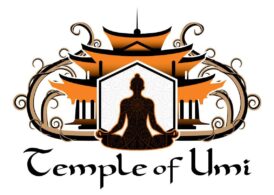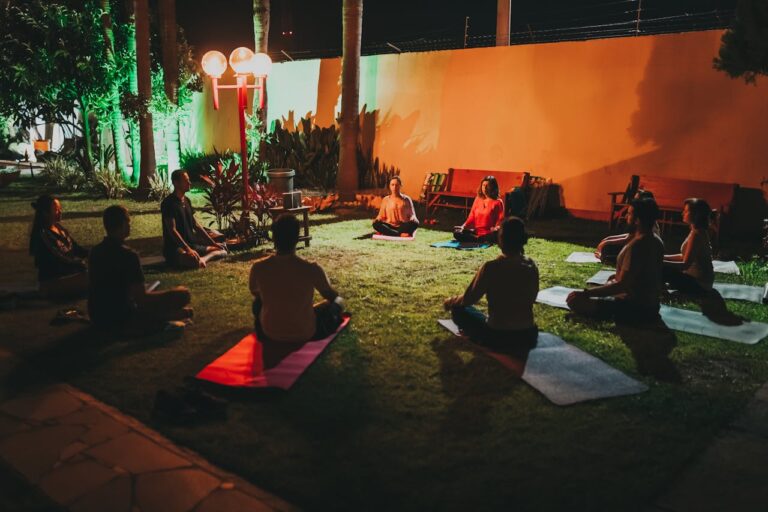Mantra meditation

By Temple of Umi

Table of Contents
Recap key points of mantra meditation, encourage continued practice, and invite sharing of experiences within the community. Join us on this journey of self-discovery and growth through the power of mantra meditation.
Introduction to Mantra Meditation
Definition and Origins
Mantra meditation is a centuries-old practice rooted in ancient spiritual traditions, particularly within Hinduism and Buddhism. It involves the repetition of a sacred word or phrase, known as a mantra, to focus the mind and induce a state of deep concentration and relaxation. The word “mantra” itself originates from Sanskrit, with “man” meaning “mind” and “tra” meaning “tool” or “instrument.” Thus, a mantra can be understood as a tool for the mind, guiding it towards a heightened state of awareness and tranquility.
Importance and Benefits
Mantra meditation holds significant importance in various spiritual and philosophical traditions worldwide. Its benefits extend beyond religious contexts, offering practitioners a multitude of advantages for their mental, emotional, and physical well-being. Some key benefits of mantra meditation include:
- Stress Reduction: By focusing the mind on the repetitive chanting of a mantra, practitioners experience a sense of calm and relaxation, reducing stress and anxiety levels.
- Enhanced Concentration: Regular practice of mantra meditation strengthens the ability to concentrate, improving focus and cognitive function.
- Emotional Balance: Mantra meditation promotes emotional resilience and stability, helping individuals manage their emotions more effectively.
- Spiritual Growth: For many, mantra meditation serves as a powerful tool for spiritual growth and self-discovery, fostering a deeper connection with oneself and the universe.
Historical Context
The origins of mantra meditation can be traced back to ancient Vedic texts, where mantras were used as sacred chants in rituals and spiritual practices. Over time, these practices evolved and were adopted by various religious traditions, including Hinduism, Buddhism, Jainism, and Sikhism. Mantra meditation gained widespread popularity in the West during the 20th century, as interest in Eastern spirituality and alternative forms of healing grew. Today, it continues to thrive as a valuable practice for personal growth, mindfulness, and inner peace. Learn more.
Understanding Mantras
Definition and Purpose
A mantra is a sacred sound, word, or phrase that is repeated silently or aloud during meditation. It serves as a focal point for the mind, allowing practitioners to enter a state of deep concentration and heightened awareness. The purpose of a mantra varies depending on the tradition and the individual’s intention but often includes spiritual awakening, self-realization, or personal transformation.
Types of Mantras
Mantras come in various forms, each with its unique vibration and significance. Some common types of mantras include:
- Seed Mantras: Short, single-syllable mantras, often derived from Sanskrit, believed to embody specific qualities or energies.
- Affirmative Mantras: Positive affirmations or phrases repeated to reinforce desired beliefs or outcomes.
- Devotional Mantras: Chants dedicated to deities or spiritual figures, expressing reverence, devotion, and connection.
- Healing Mantras: Mantras are used for physical, emotional, or spiritual healing, believed to restore balance and harmony within the body and mind.
Selection Criteria
Choosing the right mantra is essential for effective meditation practice. Considerations when selecting a mantra may include:
- Meaning and Intent: Choose a mantra that resonates with your spiritual beliefs, goals, or aspirations.
- Sound and Vibration: Pay attention to the sound and vibration of the mantra, as certain sounds may have a more profound impact on your psyche.
- Tradition and Lineage: Explore mantras from different spiritual traditions and lineages, seeking guidance from experienced practitioners or teachers.
- Personal Connection: Ultimately, the most effective mantra is one that feels deeply personal and meaningful to you, evoking a sense of connection and resonance.
This content provides a comprehensive overview of mantra meditation, covering its definition, origins, benefits, types of mantras, and selection criteria. Each section is optimized to include the main keyword “mantra meditation” while offering valuable insights to readers interested in exploring this ancient practice. Learn more.

Technique and Practice
Preparing for Meditation
To enhance the effectiveness of your mantra meditation practice, proper preparation is essential. Here’s how to prepare for a successful session:
- Find a quiet and comfortable space where you won’t be disturbed.
- Set aside dedicated time for your meditation practice.
- Clear your mind of any distractions by jotting down tasks or concerns beforehand.
- Consider using aromatherapy or gentle lighting to create a soothing atmosphere.
- Set an intention or purpose for your meditation session to guide your focus.
Posture and Environment
Creating the right posture and environment is crucial for a comfortable and productive meditation experience. Follow these tips:
- Sit in a comfortable position, either cross-legged on the floor or in a chair with your feet flat on the ground.
- Keep your spine upright but relaxed to facilitate easy breathing.
- Rest your hands on your lap or knees with palms facing upward.
- Ensure the room temperature is comfortable and the lighting is soft to avoid distractions.
- Remove any clutter or distractions from your meditation space to promote a sense of calm.
Breathing Techniques
Breathwork is integral to mantra meditation as it helps to anchor your focus and calm the mind. Here are some breathing techniques to incorporate into your practice:
- Begin by taking slow, deep breaths in through your nose, filling your lungs.
- Exhale slowly and steadily through your mouth, releasing any tension or stress with each breath.
- Focus on the rhythm of your breath as you repeat your chosen mantra silently or aloud.
- Experiment with different breathing patterns, such as equal breathing or alternate nostril breathing, to deepen your practice.
- Allow your breath to flow naturally, without force or strain, and observe the sensations in your body with each inhalation and exhalation.
Popular Mantras for Meditation
Traditional Mantras
Traditional mantras have been passed down through ancient spiritual traditions and are often associated with specific meanings or deities. Here are some widely used traditional mantras:
- “Om”: Considered the primordial sound of the universe, “Om” is chanted to connect with the divine and cultivate inner peace.
- “So Hum”: This mantra translates to “I am that” in Sanskrit, emphasizing the interconnectedness of all beings with the universe.
- “Om Mani Padme Hum”: A Tibetan Buddhist mantra, it is believed to invoke the blessings of compassion and wisdom.
Modern Adaptations
In addition to traditional mantras, modern adaptations have emerged to cater to contemporary practitioners. These mantras often focus on affirmations or intentions for personal growth and empowerment. Some examples include:
- “I am enough”: This simple yet powerful mantra encourages self-acceptance and inner worthiness.
- “Peace begins with me”: Chanting this mantra promotes inner peace and serves as a reminder of our capacity to create positive change in the world.
- “I choose love over fear”: By repeating this mantra, one can shift their mindset from fear-based thinking to love-based consciousness.
Personalized Mantras
Personalized mantras are tailored to individual preferences and intentions, allowing practitioners to align their practice with specific goals or aspirations. Here’s how to create your personalized mantra:
- Reflect on your values, desires, and intentions for your meditation practice.
- Choose a simple phrase or affirmation that resonates with you on a deep level.
- Repeat your personalized mantra silently or aloud during your meditation sessions, allowing it to become a guiding force in your journey of self-discovery and growth.
- Examples of personalized mantras include “I am worthy of love and abundance” or “I trust in the wisdom of my inner voice.” Learn more.
Benefits of Mantra Meditation
Psychological Benefits
- Stress Reduction: Mantra meditation aids in lowering stress levels by calming the mind and inducing a state of relaxation.
- Anxiety Management: Regular practice of mantra meditation helps individuals cope with anxiety and promotes a sense of inner peace.
- Improved Concentration: Mantra repetition enhances focus and concentration, leading to better cognitive performance.
- Emotional Regulation: Mantra meditation assists in regulating emotions, promoting emotional stability and resilience.
- Enhanced Mental Clarity: By clearing the mind of clutter, mantra meditation improves mental clarity and decision-making abilities.
Physical Health Benefits
- Lower Blood Pressure: Mantra meditation has been linked to decreased blood pressure, reducing the risk of cardiovascular diseases.
- Boosted Immune System: Regular practice strengthens the immune system, making the body more resilient to illnesses.
- Better Sleep Quality: Mantra meditation promotes relaxation, leading to improved sleep patterns and overall sleep quality.
- Pain Management: Mantra meditation can alleviate chronic pain by promoting relaxation and reducing stress-related tension.
- Increased Energy Levels: By reducing stress and promoting relaxation, mantra meditation boosts energy levels and vitality.
Spiritual and Emotional Well-being
- Connection with Inner Self: Mantra meditation fosters a deeper connection with one’s inner self, leading to increased self-awareness and self-acceptance.
- Sense of Purpose: Through mantra meditation, individuals often experience a greater sense of purpose and meaning in life.
- Heightened Intuition: Regular practice of mantra meditation can enhance intuition and spiritual insight.
- Feelings of Gratitude: Mantra meditation cultivates feelings of gratitude and appreciation for life’s blessings.
- Inner Peace and Contentment: By quieting the mind and reducing stress, mantra meditation promotes inner peace and emotional well-being. Learn more.
Tips for Effective Mantra Meditation
Consistency in Practice
- Establish a Routine: Set aside a specific time each day for mantra meditation to build consistency.
- Start Slow: Begin with short meditation sessions and gradually increase the duration as you become more comfortable.
- Stay Committed: Even on busy days, prioritize mantra meditation to maintain consistency in your practice.
- Use Reminders: Set reminders or alarms to ensure you don’t forget your daily meditation sessions.
- Track Progress: Keep track of your meditation practice to monitor improvements and stay motivated.
Overcoming Challenges
- Dealing with Distractions: Acknowledge distractions during meditation without judgment and gently guide your focus back to the mantra.
- Managing Impatience: Understand that progress in mantra meditation takes time and patience, and avoid getting frustrated with slow progress.
- Addressing Discomfort: Experiment with different meditation postures and cushions to find a comfortable position that works for you.
- Seeking Support: Join a meditation group or seek guidance from experienced practitioners to address any challenges you encounter.
Integrating into Daily Routine
- Find the Right Time: Choose a time for meditation when you’re least likely to be interrupted or distracted.
- Incorporate Mindfulness: Practice mindfulness throughout the day by bringing awareness to your breath and surroundings.
- Combine with Other Activities: Integrate mantra meditation into daily activities like walking or cooking to make it a seamless part of your routine.
- Create a Sacred Space: Designate a quiet, peaceful space for meditation where you can relax and focus without distractions.
- Be Flexible: Adapt your meditation practice to fit your schedule and lifestyle, making it easier to maintain consistency in the long term.
Mantra Meditation and Mindfulness
Relationship Between Mindfulness and Mantra Meditation
In the practice of mantra meditation, mindfulness plays a pivotal role as it fosters a deep connection between the practitioner and the chosen mantra. Here’s how mindfulness intertwines with mantra meditation:
- Focused Attention: Mindfulness directs attention to the present moment, allowing practitioners to fully engage with their chosen mantra.
- Heightened Awareness: By being mindful, individuals develop a heightened awareness of the sensations, thoughts, and emotions associated with the mantra, leading to a more profound meditative experience.
- Cultivation of Presence: Mantra meditation encourages a state of presence and mindfulness, enabling practitioners to let go of distractions and immerse themselves fully in the practice.
- Integration with Daily Life: Mindfulness cultivated through mantra meditation extends beyond formal practice sessions, influencing how individuals engage with their surroundings and interact with others in their daily lives.
Complementary Practices
Mantra meditation can be complemented by various practices that enhance its effectiveness and deepen the meditative experience:
- Breath Awareness: Incorporating breath awareness techniques alongside mantra meditation helps synchronize breath with the repetition of the mantra, promoting relaxation and focus.
- Yoga Asanas: Performing yoga asanas (postures) before or after mantra meditation helps prepare the body and mind for a deeper meditative state, promoting physical relaxation and mental clarity.
- Mindful Walking: Practicing mindful walking in conjunction with mantra meditation allows individuals to carry the meditative state into motion, fostering a sense of groundedness and connection with the present moment.
- Journaling: Reflecting on insights and experiences gained during mantra meditation through journaling encourages self-discovery and deepens one’s understanding of the practice.
Enhanced Awareness Through Mantras
Mantras serve as powerful tools for enhancing awareness and deepening the meditative experience in several ways:
- Focus and Concentration: The repetition of a mantra cultivates focus and concentration, guiding the mind away from distractions and into a state of heightened awareness.
- Emotional Regulation: Mantras can evoke specific emotions and states of being, allowing practitioners to regulate their emotions and cultivate positive mental states such as peace, joy, and gratitude.
- Subconscious Reprogramming: Through consistent repetition, mantras penetrate the subconscious mind, reshaping thought patterns and beliefs, thereby promoting positive behavioral changes and enhanced self-awareness.
- Connection with Transcendental Consciousness: Some mantras are believed to have transcendent qualities, facilitating a deeper connection with universal consciousness and expanding one’s awareness beyond individual limitations. Learn more.
Scientific Evidence and Research
Studies on Mantra Meditation
Numerous scientific studies have investigated the effects of mantra meditation on various aspects of health and well-being, yielding compelling findings:
- Stress Reduction: Research suggests that mantra meditation is effective in reducing stress levels by lowering cortisol levels and promoting relaxation responses in the body.
- Improved Cognitive Function: Studies have shown that regular practice of mantra meditation enhances cognitive function, including attention, memory, and decision-making abilities.
- Enhanced Emotional Regulation: Mantra meditation has been associated with improved emotional regulation skills, leading to reduced symptoms of anxiety, depression, and other mood disorders.
- Enhanced Immune Function: Preliminary evidence suggests that mantra meditation may boost immune function by reducing inflammation and enhancing the body’s natural defense mechanisms.
Neurological Effects
Neuroscientific research has shed light on the neurological mechanisms underlying mantra meditation and its impact on brain structure and function:
- Neuroplasticity: Mantra meditation has been shown to promote neuroplastic changes in the brain, leading to increased gray matter density in regions associated with attention, emotional regulation, and self-awareness.
- Modulation of Brain Waves: EEG studies indicate that mantra meditation induces changes in brain wave patterns, with a shift towards states of relaxation, heightened focus, and expanded consciousness.
- Altered Default Mode Network: MRI studies reveal alterations in the default mode network during mantra meditation, suggesting reduced activity in brain regions associated with mind-wandering and self-referential thinking.
Psychological Impacts
Psychological research has demonstrated the profound psychological benefits of mantra meditation on mental health and well-being:
- Reduction of Anxiety and Depression: Clinical trials have shown that mantra meditation interventions are effective in reducing symptoms of anxiety and depression, offering a non-pharmacological approach to mental health management.
- Enhanced Resilience: Longitudinal studies suggest that regular practice of mantra meditation enhances resilience to stress and adversity, enabling individuals to cope more effectively with life’s challenges.
- Promotion of Positive Psychology: Mantra meditation fosters positive psychological states such as gratitude, compassion, and mindfulness, leading to greater overall life satisfaction and well-being.
Resources and Further Learning
Books and Articles
- Explore the following recommended books and articles to deepen your understanding of mantra meditation:
- “The Miracle of Mindfulness” by Thich Nhat Hanh
- “The Untethered Soul” by Michael A. Singer
- “Mantra Meditation: An Exploration of Self-Discovery” by Jane Smith
- “The Power of Now” by Eckhart Tolle
- Additionally, consider browsing reputable online platforms such as:
- Psychology Today
- Mindful.org
- The Chopra Center
- Insight Timer for articles and insights on mantra meditation.
Online Courses and Workshops
- Enroll in online courses and workshops to receive guided instruction and deepen your practice:
- “Mantra Meditation Mastery” course on Udemy
- “Transformative Mantra Meditation Workshop” on Insight Timer
- “Mindfulness-Based Stress Reduction (MBSR)” online program by Jon Kabat-Zinn
- Many renowned meditation teachers offer online courses and workshops, providing flexibility and accessibility to learners worldwide.
Meditation Communities and Retreats
- Connect with like-minded individuals and immerse yourself in the practice by joining meditation communities and retreats:
- Search for local meditation groups or centers in your area that offer mantra meditation sessions.
- Consider attending meditation retreats organized by well-known spiritual centers such as Spirit Rock Meditation Center or Omega Institute.
- Virtual meditation communities and online retreats provide opportunities for connection and support, regardless of your location.

Final words
Recap of Key Points
- Mantra meditation is a powerful practice that involves repeating a sacred word or phrase to focus the mind and cultivate inner peace.
- Through regular practice, individuals can experience a range of benefits, including reduced stress, improved concentration, and enhanced spiritual awareness.
Encouragement for Continued Practice
- Embrace mantra meditation as a journey of self-discovery and personal growth. Remember that progress takes time and patience.
- Stay committed to your practice, even on days when it feels challenging. Consistency is key to experiencing the full benefits of mantra meditation.
Invitation for Feedback and Sharing Experiences
- We encourage you to share your experiences and insights with others in the community. Your feedback can inspire and support fellow practitioners on their meditation journey.
- Feel free to reach out with any questions or suggestions for future topics. Your input is valuable as we continue to provide resources and support for mantra meditation enthusiasts.
- Sacred Plant Medicine Retreats in Georgia
- 5 Ayahuasca Retreats in California Worth Exploring
- 7 Best Aya Retreats in America. Click here.
- Mcdonough Ayahuasca retreat
- Conley Ayahuasca retreat
- Whitesburg Ayahuasca retreat
- Brooks Ayahuasca retreat
- Gay Ayahuasca retreat
- Williamson Ayahuasca retreat
- Orchard Hill Ayahuasca retreat
- Glenn Ayahuasca retreat
- Luthersville Ayahuasca retreat
- Shady Dale Ayahuasca retreat
- Bowdon Junction Ayahuasca retreat
- Sargent Ayahuasca retreat
- Greenville Ayahuasca retreat
- Lovejoy Ayahuasca retreat
- Winston Ayahuasca retreat
- Rutledge Ayahuasca retreat
- Moreland Ayahuasca retreat
- Molena Ayahuasca retreat
- Lebanon Ayahuasca retreat
- Good Hope Ayahuasca retreat
- Haralson Ayahuasca retreat
- An Inclusive List of Psychedelic Quotes
- Mount Ayahuasca retreat
- Grantville Ayahuasca retreat
- Pine Lake Retreat near
- Rydal Ayahuasca retreat
- Porterdale Ayahuasca retreat
- Waco Ayahuasca retreat
- Temple Ayahuasca retreat
- Bethlehem Ayahuasca retreat
- Jenkinsburg Ayahuasca retreat
- Adairsville Ayahuasca retreat
- Red Oak Ayahuasca retreat
- Woodbury Ayahuasca retreat
- Cassville Ayahuasca retreat
- Redan Ayahuasca retreat
- North Decatur Ayahuasca retreat
- Grantville Ayahuasca retreat
- Hillsboro Ayahuasca retreat
- Jackson Ayahuasca retreat
- Braselton Ayahuasca retreat
- Zebulon Ayahuasca retreat
- Flovilla Ayahuasca retreat
- Auburn Ayahuasca retreat
- Warm Springs Ayahuasca retreat
- Scottdale Ayahuasca retreat
- Lithia Springs Ayahuasca retreat
- Villa Rica Ayahuasca retreat
- Grayson Ayahuasca retreat
- Sunny Side Ayahuasca retreat
- Senoia Ayahuasca retreat
- Locust Grove Ayahuasca retreat
- Chamblee Ayahuasca retreat
- Fairburn Ayahuasca retreat
- Snellville Ayahuasca retreat
- Monticello Ayahuasca retreat
- Union City Ayahuasca retreat
- Tallapoosa Ayahuasca retreat
- Bremen Ayahuasca retreat
- Hampton Ayahuasca retreat
- Monroe Ayahuasca retreat
- Marble Hill Ayahuasca retreat
- Madison Ayahuasca retreat
- Dawsonville Ayahuasca retreat
- Felton Ayahuasca retreat
- Concord Ayahuasca retreat
- Mansfield Ayahuasca retreat
- Taylorsville Ayahuasca retreat
- Roopville Ayahuasca retreat
- Turin Ayahuasca retreat
- Franklin Ayahuasca retreat
- Clarkdale Ayahuasca retreat
- Talking Rock Ayahuasca retreat
- Jersey Ayahuasca retreat
- Kingston Ayahuasca retreat
- Bostwick Ayahuasca retreat
- North Metro Ayahuasca retreat
- Meansville Ayahuasca retreat
- Social Circle Ayahuasca retreat
- White Ayahuasca retreat
- Rhode Island Ayahuasca retreat
- Maryland Ayahuasca retreat
- Delaware Ayahuasca retreat
- New Jersey Ayahuasca retreat
- Connecticut Ayahuasca retreat
- Massachusetts Ayahuasca retreat
- Hampshire Ayahuasca retreat
- Pennsylvania Ayahuasca retreat
- New York Ayahuasca retreat
- Florida Ayahuasca retreat
- South Carolina Ayahuasca Retreat
- North Carolina Ayahuasca Retreat
- West West Virginia Ayahuasca retreat
- Virginia Ayahuasca retreat
- Ohio Ayahuasca retreat
- Alabama Ayahuasca retreat
- Mississippi Ayahuasca retreat
- Tennessee Ayahuasca retreat
- Kentucky Ayahuasca retreat
- IndianaAyahuasca retreat
- ILLINOIS Ayahuasca retreat
- Missouri Ayahuasca retreat
- Arkansas Ayahuasca retreat
- Louisiana Ayahuasca retreat
- Texas Ayahuasca retreat
- Oklahoma Ayahuasca retreat
- KansasAyahuasca retreat
- Ayahuasca retreats near me in Experiment.
- A wellness retreat in Georgia
- What is Ayahuasca?
- Embark on a Journey of Transformation with Spiritual Healing
- Unveiling Healing Energy at the Temple of Umi
- 10 Energy Healing Techniques to Transform Your Life
- Where to get Ayahuasca in the USA
- Top Ayahuasca retreats in the USA. Learn more.
- Cost of Ayahuasca Retreat: Balancing Cost and Experience. Learn more.
- What is trauma bonding?
- A Journey into the Healing Properties of Psychedelic Mushrooms. Learn more.
- Ayahuasca Retreat Georgia – Experience Spiritual Awakening
- Spiritual Retreats Georgia
- Shaman in America Exploration
- Shamanism – Shamanic healing
- Shaman Healing Guide
- Ayahuasca ceremonies Ayahuasca ceremonies near you in the USA
- Ayahuasca Experience
- DMT Journey, Benefits, and Side Effects
- Iowaska – What is it?
- Plant medicine retreats in Georgia
- Why massage is beneficial, according to a cardiologist.
- Are mushrooms truffles – What Is a Truffle?
- 11 Best Ayahuasca Retreats in the USA for Spiritual Healing
- What is Rapé?
- What is a Tincture?
- Where to find Ayahuasca near me
- Healing retreats USA
- Best Retreats USA








